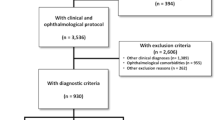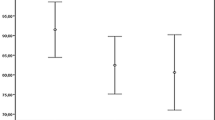Abstract
Retinal nerve fiber layer thickness (RNFL) measured by means of Optical Coherence Tomography (OCT) has been used as a marker not only of ophthalmologic diseases but also of neurodegenerative diseases such as Alzheimer’s disease (AD) and mild cognitive impairment (MCI). The purpose of this work was to demonstrate that patients with amnestic MCI show an intermediate RNFL thickness between normality and AD, and a macular volume and thickness as well. In a cross-sectional study we consecutively recruited 18 patients with AD, 21 with MCI, and 41 healthy controls. OCT was performed in all of them to measure circumpapillary RNFL thickness in µm, as well as macular volume and thickness. In the analysis of variance we saw that RNFL was thinner in MCI patients compared with controls, and it was also thinner in AD patients compared with MCI patients and controls. With regard to the macular measurements in mm3, MCI patients had the greatest macular volume in comparison with AD patients and controls. In turn the controls had greater macular volume than AD patients. The decreased RNFL thickness in MCI and AD patients suggests loss of retinal neurons and their axons. The increased thickness and macular volume have never been reported before in aMCI. This finding could be explained by inflammation and/or gliosis in early stages of AD. OCT could be a useful marker of AD for early detection and monitoring progression.


Similar content being viewed by others
References
Prince M, Brice R, Ferry R. World Alzheimer report 201 Illinois: Alzheimer Disease Intenational, 201 Available at: http:www.alz.co.uk/worldreport2011, Accessed 11 March 2014
Morris JM, Nagy Z (2004) Alzheimer’s disease in the neuropathology of dementia. Cambridge University Press, UK, pp 161–206
Hinton DR, Sadun AA, Blanks JC, Miller CA (1986) Optic-nerve degeneration in Alzheimer’s disease. N Engl J Med 315:485–487
Hof PR, Vogt BA, Bouras C, Morrison JH (1997) Atypical form of Alzheimer’s disease with prominent posterior cortical atrophy: a review of lesion distribution and circuit disconnection in cortical visual pathways. Vision Res 37:3609–3625
Blanks JC, Torigoe Y, Hinton DR, Blanks RH (1996) Retinal pathology in Alzheimer’s disease. I. Ganglion cell loss in foveal/parafoveal retina. Neurobiol Aging 17:377–384
Trick GL, Trick LR, Morris P, Wolf M (1995) Visual field loss in senile dementia of the Alzheimer’s type. Neurology 45:68–74
Petersen RC, Smith GE, Waring SC, Ivnik RJ, Tangalos EG, Kokmen E (1999) Mild cognitive impairment: clinical characterization and outcome. Arch Neurol 56:303–308
Levey A, Lah J, Goldstein F, Steenland K, Bliwise D (2006) Mild cognitive impairment: an opportunity to identify patients at high risk for progression to Alzheimer’s disease. Clin Ther 28:991–1001
Werner P, Korzcyn AD (2008) Mild cognitive impairment: conceptual, assessment, ethical, and social issues. Clin Interv Aging 3:413–420
Winblad B, Palmer K, Kivipelto M, Jelic V, Fratiglioni L, Wahlund LO, Nordberg A, Bäckman L, Albert M, Almkvist O, Arai H, Basun H, Blennow K, de Leon M, DeCarli C, Erkinjuntti T, Giacobini E, Graff C, Hardy J, Jack C, Jorm A, Ritchie K, van Duijn C, Visser P, Petersen RC (2004) Mild cognitive impairment—beyond controversies, towards a consensus: report of the International Working Group on Mild Cognitive Impairment. J Intern Med 256:240–246
Petersen RC, Roberts RO, Knopman DS, Boeve BF, Geda YE, Ivnik RJ, Smith GE, Jack CR Jr (2009) Mild cognitive impairment: ten years later. Arch Neurol 66:1447–1455
Petersen RC, Stevens JC, Ganguli M, Tangalos EG, Cummings JL, DeKosky ST (2001) Practice parameter: early detection of dementia: mild cognitive impairment (an evidence-based review). Report of the Quality Standards Subcommittee of the American Academy of Neurology. Neurology 56:1133–1142
Morris JC, Cummings J (2005) Mild cognitive impairment (MCI) represents early-stage Alzheimer’s disease. J Alzheimers Dis 7:235–239
Makersbery WR, Schmitt FA, Kryscio RJ, Davis DG, Smith CD, Wekstein DR (2006) Neuropathologic substrate of mild cognitive impairment. Arch Neurol 63:38–46
Ikram MK, Cheung CY, Wong TY, Chen CP (2012) Retinal pathology as biomarker for cognitive impairment and Alzheimer’s disease. J Neurol Neurosurg Psychiatry 83:917–922
Jaffe G-J, Caprioli J (2004) Optical coherence tomography to detect and manage retinal disease and glaucoma. Am J Ophthalmol 137:156–169
Hassenstein A, Spital G, Scholz F, Henschel A, Richard G, Pauleikhoff D (2009) Optical coherence tomography for macula diagnostics. Review of methods and standardized application concentrating on diagnostic and therapy control of age-related macula degeneration. Ophthalmologe 106:116–126
Ratchford JN, Quigg ME, Conger A, Frohman T, Frohman E, Balcer LJ, Calabresi PA, Kerr DA (2009) Optical coherence tomography helps differentiate neuromyelitis optica and MS optic neuropathies. Neurology 73:302–308
Hajee M-E, March W-F, Lazzaro D-R et al (2009) Inner retinal layer thinning in Parkinson disease. Arch Ophthalmol 127:737–741
Ascaso FJ, Cabezón L, Quintanilla MA, Gutiérrez-Galve L, López-Antón R, Cristóbal JA, Lobo A (2010) Retinal nerve fiber layer thickness mesured by optical coherence tomography in patients with schizophrenia: a short report. Eur J Psychiatry 24:227–235
Parisi V, Restuccia R, Fattapposta F, Mina C, Bucci M-G, Pierelli F (2001) Morphological and functional retinal impairment in Alzheimer’s disease patients. Clin Neurophysiol 112:1860–1867
Iseri P-K, Altinas O, Tokay T, Yuksel N (2006) Relationship between cognitive impairment and retinal morphological and visual functional abnormalities in Alzheimer disease. J Neuroophthalmol 26:18–24
Berisha F, Feke G-T, Trempe C-L, McMeel J-W, Schepens C-L (2007) Retinal abnormalities in early Alzheimer´s disease. Invest Ophthalmol Vis Sci 48:2285–2289
Paquet C, Boissonnot M, Roger F, Dighiero P, Gil R, Hugon J (2007) Abnormal retinal thickness in patients with mild cognitive impairment and Alzheimer’s disease. Neurosci Lett 420:97–99
Yu JC, Feng IF, Xiang Y, Huanq JH, Savini G, Parisi V, Yang WJ, Fu Xa (2014) Retinal fiber nerve layer thickness changes in Parkinson disease: a meta-analysis. PLoS One 9:e85718
Moreno-Ramos T, Benito-León J, Villarejo A, Bermejo-Pareja F (2013) Retinal nerve fiber layer thinning in dementia associated with Parkinson’s disease, dementia with Lewy bodies, and Alzheimer’s disease. J Alzheimers Dis 34:659–664
Blanks JC, Schmidt SY, Torigoe Y, Porrello KV, Hinton DR, Blanks RH (1996) Retinal pathology in Alzheimer’s disease II. Regional neuron loss and glial changes in GCL. Neurobiol Aging 17:385–395
Lamirel C, Newman N, Biousse V (2009) The use of optical coherence tomography in Neurology. Rev Neurol Dis 6(4):e105–e120
Sakata L-M, Deleon-Ortega J, Sakata V, Girkin C-A (2009) Optical coherence tomography of the retina and optic nerve- a review. Clin Exp Ophthalmol 37:90–99
Streit WJ, Xue QS, Braak H, Del Tredici K (2014) Presence of severe neuroinflammation does not intensify neurofibrillary degeneration in human brain. Glia 62(1):96–105
Lobo A, Saz P, Marcos G et al (1999) Revalidation and standardization of the cognition mini-exam (first Spanish version of the Mini-Mental Status Examination) in the general geriatric population. Med Clin (Barc) 112:767–774
Katz S, Ford AB, Moskowitz RW et al (1963) Studies of illness in the aged. The index of ADL: a standardized measure of biological and psychosocial function. JAMA 185:914–919
Alvarez M, De Alaiz AT, Brun E, Cabañeros JJ, Calzon M, Cosio I (1992) Capacidad funcional de pacientes mayores de 65 años, según el índice de Katz. Fiabilidad del método. Aten Primaria 10:812–816
Lawton MP, Brody EM (1969) Assessment of older people: self-maintaining and instrumental activities of daily living. Gerontologist 9:179–186
Tárraga LL (1995) Evaluación del deterioro cognitivo y functional de la demencia. Escalas de mayor interés en la Atención Primaria. In: Boada M, Tárraga LL (eds) El médico ante la demencia y su entorno, Módulo 1. Bayer S.A, Barcelona, pp 37–50
Pinheiro JC, Bates DM (2009) Mixed-effects models in S and S-PLUS, 2nd edn. Springer, New York
Blennow K, Hampel H (2003) CSF markers for incipient Alzheimer’s disease. Lancet Neurol 2:605–613
Galasko D (2005) Biomarkers for Alzheimer’s diseased clinical needs and application. J Alzheimers Dis 8:339–346
He XF, Liu YT, Peng C, Zhang F, Zhuang S, Zhang JS (2012) Optical coherence tomography assessed retinal nerve fiber layer thickness in patients with Alzheimer’s disease: a meta-analysis. Int J Ophthalmol 5:401–405
Frohman E-M, Fujimoto J-G, Frohman T-C et al (2008) Optical coherence tomography: a window into the mechanisms of multiple sclerosis. Nat Clin Pract Neurol 4:664–675
Deng YL, Chen Y, Xie LQ, Wang G, Xu Wei, Tang YD, Wang Y, Chen SD (2009) Morphological change of retina in mild Alzheimer’s disease. 8: 397–400
Chi Y, Wang YH, Yang L (2010) The investigation of retinal nerve fiber loss in Alzheimer’s disease. 46: 134–139
Kesler A, Vakhapova V, Korczyn AD, Naftaliev E, Neudorfer M (2011) Retinal thickness in patients with mild cognitive impairment and Alzheimer’s disease. Clin Neurol Neurosurg 113:523–526
Kirbas S, Turkyilmaz K, Anlar O, Tufekci A, Durmus M (2013) Retinal nerve fiber layer thickness in patients with Alzheimer disease. J Neuroophthalmol 33:58–61
Schmidtke K, Hermeneit S (2008) High rate of conversion to Alzheimer´s disease in a cohort of amnestic MCI patients. Int Psychogeriatr 20:96–108
Gramer E, Dirmeyer M (1998) Optical coherence tomography (OCT) to measure nerve fiber layer thickness in normal eyes. Invest Ophthalmol Vis Sci 39(4):S933 (abstract)
Heneka MT, Rodriguez JJ, Verkhratsky A (2010) Neuroglia in neurodegeneration. Brain Res Rev 63:189–211
Verkhratsky A, Olabarria M, Noristani HN, Yeh CY, Rodriguez JJ (2010) Astrocytes in Alzheimer’s disease. Neurotherapeutics 7:399–412
Reichenbach A, Wurm A, Pannicke T, Iandiev I, Wiedemann P, Bringmann A (2007) Müller cells as players in retinal degeneration and edema. Graefe’s Arch Clin Exp Ophthalmol 245:627–636
Bringmann A, Iandiev I, Pannicke T et al (2009) Cellular signaling and factors involved in Müller cell gliosis: neuroprotective and detrimental effects. Prog Retin Eye Res 28:423–451
Bringmann A, Wiedemann P (2011) Müller glial cells in retinal disease. Ophthalmologica 227:1–19
Fujino Y, Delucia MW, Davies P, Dickson DW (2004) Ballooned neurones in the limbic lobe are associated with Alzheimer type pathology and lack diagnostic specificity. Neuropathol Appl Neurobiol 30:676–682
Parisi V (2003) Correlation between morphological and functional retinal impairment in patients affected by ocular hypertension, glaucoma, demyelinating optic neuritis and Alzheimer’s disease. Semin Ophthalmol 18:50–57
Conflicts of interest
On behalf of all authors the corresponding author declares that there are no conflicts of interest.
Ethical standard
This work was conducted in accordance with the 1964 Declaration of Helsinki and its later amendments. It was approved by the local ethical committee. All persons included in the study gave their informed consent prior their inclusion.
Author information
Authors and Affiliations
Corresponding author
Rights and permissions
About this article
Cite this article
Ascaso, F.J., Cruz, N., Modrego, P.J. et al. Retinal alterations in mild cognitive impairment and Alzheimer’s disease: an optical coherence tomography study. J Neurol 261, 1522–1530 (2014). https://doi.org/10.1007/s00415-014-7374-z
Received:
Revised:
Accepted:
Published:
Issue Date:
DOI: https://doi.org/10.1007/s00415-014-7374-z




